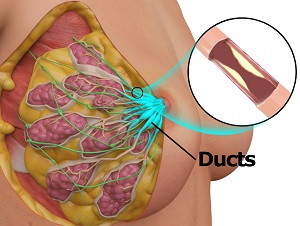
What is Duct Ectasia?
Duct ectasia, or mammary duct ectasia, is a benign or noncancerous breast condition in which one or more milk ducts (tubes that transfer milk to the nipple) become swollen and blocked. This can cause a build-up that leads to an infectious condition called periductal mastitis.
Causes of Duct Ectasia
Duct ectasia is caused by natural breast changes that occur with age. Breasts have milk-producing glands known as lobules and tubes that convey milk to the nipple known as ducts. Fibrous, fatty, and glandular tissue surrounds the lobules and ducts to give the breast its distinct shape and density. As women approach menopause and the breast starts to age (age 35 years and on), the ducts under the nipple widen and shorten leading to duct ectasia.
Signs and Symptoms of Duct Ectasia
Some signs and symptoms of duct ectasia include:
- Breast pain and tenderness
- Abnormal nipple discharge
- A lump felt under the nipple
- An inward pulling of the nipple (inverted nipple) as a result of duct shortening
- Swelling, redness, and inflammation in the nipple area
- Fever due to associated infection
Diagnosis of Duct Ectasia
In order to diagnose duct ectasia, your doctor may perform the following:
- A review of your medical history to check for any previous history of breast conditions
- A clinical breast examination to check for any lumps and other problems, such as nipple discharge or changes in the appearance of the breasts
- Mammogram – an X-ray examination of the breast to check for subtle changes not detected during a physical exam
- Ultrasound scan – use of high-frequency sound waves to create pictures of breast tissue for detailed examination
- Fine-needle aspiration – use of fine needle and syringe to aspirate cell samples from the infected area for microscopic analysis
- Core biopsy – use of a needle to extract a sample of breast tissue from a suspicious area for microscopic analysis
Treatment for Duct Ectasia
Most cases of duct ectasia do not require any treatment as it is a normal process of ageing and symptoms often improve on their own. However, if symptoms persist, your doctor may recommend further measures including the following:
- Over-the-counter pain medications such as acetaminophen or ibuprofen or a non-steroidal anti-inflammatory drug (NSAID) to relieve pain and fever
- Antibiotic medications to treat the underlying infection
- Warm compresses to relieve pain and discomfort
- Surgical removal of the affected duct through a small surgical cut along the outer border of the areola (the darker circular area of skin around the nipple). This procedure is usually performed under anaesthesia as an outpatient (same-day) surgery. The surgery will leave a small scar, but this will fade over time.
